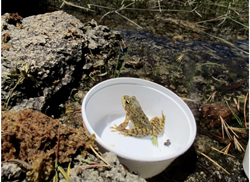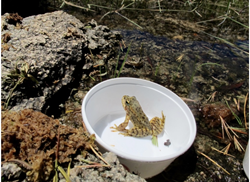
Each yellow-legged frog was transported int their own container that labeled their PIT tag number and sex.
What makes this effort so worthwhile is knowing that all of the hard work and countless hours we’ve invested here at the Zoo gives these frogs the best possible head start in hopefully ensuring that their populations in the wild will survive
OAKLAND, Calif. (PRWEB)
August 03, 2021
Last Wednesday, in response to their rapidly declining population, 33 Sierra Nevada yellow-legged frogs (SNYLF) were flown 50-miles via helicopter to their release site in Sequoia Kings Canyon National Park. The ongoing effort, with Oakland Zoo’s releases taking place every year – and with this release and many others in partnership with San Francisco Zoo & Gardens – is in hopes of re-establishing a healthy breeding population in the wild. Today marks Oakland Zoo’s 18th release, with 626 yellow-legged frogs across 3 different species – all of them categorized as “threatened.”
The threats facing the Sierra Nevada yellow-legged frog population are two-fold: non-native invasive fish have been introduced into their lakes by humans for recreational fishing, with those fish preying on the SNYLF. The second issue is the devastating Chytrid disease, responsible in the global amphibian decline. Chytrid is caused by a fungus that grows on the frogs’ skin, making it difficult for the frogs to regulate their water and salt intake, and in turn, can lead to cardiac arrest.
A tremendous amount of work goes into the frog release programs at Oakland Zoo, before the frogs are viable enough to be released back into the wild.
The process begins with tadpoles collected from the wild and brought to the Zoo, to be nurtured in a carefully maintained, optimal environment needed in order to complete a full life cycle. This includes anti-fungal chytrid treatments during their ‘froglet’ stage to inoculate them against that virus once they return to the wild. Once treatment is complete, they are pit-tagged (similar to microchipping a dog or cat) for monitoring. After tagging, they receive their inoculations, swabbed one last time for chytrid, and if all is clear, they get ready for their flight to their release site. This entire process takes 1-2 years in total.
Eleven Oakland Zoo staff, interns, and volunteers work seven days a week, 365 days a year, on all three yellow-legged frog programs as well as the Zoo’s Puerto Rican crested toad program.
“What makes this effort so worthwhile is knowing that all of the hard work and countless hours we’ve invested here at the Zoo gives these frogs the best possible head start in hopefully ensuring that their populations in the wild will survive,” says Samantha Sammons, Conservation Biologist at Oakland Zoo.
The primary goal of these programs is to release healthy frogs, large enough to avoid predation, and with an immune response to chytrid disease, thus increasing the breeding population to help re-stabilize the species population.
“The reintroduction efforts we have recently been conducting are one of the few tools currently available to try to recover these species. They require close collaboration by multiple partners, and the expertise provided by cooperating zoos, like Oakland Zoo, has been essential in being able to return so many frogs to the wild”, says Danny Boiano, Aquatic Ecologist, at Sequoia and Kings Canyon National Parks.
This conservation effort will continue at Oakland Zoo, in partnership with San Francisco Zoo & Gardens, the California Department of Fish and Wildlife, and National Park Service, as long the species remains threatened. After today’s release, Oakland Zoo Biodiversity Center is holding another 230 adult frogs as they await their release later this summer. Plans are in place to retrieve 100 more tadpoles of various yellow-legged frog species by the beginning of August.
Contact:
Isabella Linares
Oakland Zoo
ilinares@oaklandzoo.org
Office: 510-632-9525 ext. 239
Erin Harrison
Oakland Zoo
eharrison@oaklandzoo.org
Office: 510-632-9525 ext. 120
ABOUT OAKLAND ZOO AND THE CONSERVATION SOCIETY OF CALIFORNIA:
Oakland Zoo, home to more than 850 native and exotic animals, is managed by the Conservation Society of California (CSC); a non-profit organization leading an informed and inspired community to take action for wildlife locally and globally. With over 25 conservation partners and projects worldwide, the CSC is committed to conservation-based education and saving species and their habitats in the wild. Oakland Zoo is dedicated to the humane treatment of animals and is accredited by the Association of Zoos and Aquariums (AZA), the national organization that sets the highest standards for animal welfare for zoos and aquariums.
Share article on social media or email:

